Frequently Asked Questions
1. €urostar Indexes – do they work?
Yes. Almost 50% of the data used in the €uroStar evaluations now comes from commercial grass-based sheep flocks which means that alot of the data included in the €uroStar indexes is independently collected by Sheep Ireland field technicians or from commercial flocks involved in various Sheep Ireland or Teagasc programs. Some of these programs include the Sheep Ireland Central Progeny Test (CPT), the Teagasc BETTER Farm programme and OviData participating flocks, Teagasc sheep research flocks, and Independent commercial flocks involved in LambPlus. These flocks use pedigree €uroStar rams for mating with their ewes, and all the data collected on the subsequent lambs born contribute to the €uroStar evaluations published for Irish sheep farmers.
Lambs are weighed regularly on the CPT and Teagasc BETTER Farm flocks, and this allows the evalution to compare the performance of different bloodlines and €uroStar-rated rams. The results show that progeny from 5-Star Terminal rams are outperforming their 1-Star counterparts throughout their lifetime. Using the 40-day weight as an example, lambs sired by 5-Star Terminal rams are weighing on average 1.0kg heavier than their 1-Star equivalents. This trend continues up until the animals are 150 days old, where again, the lambs sired by 5-
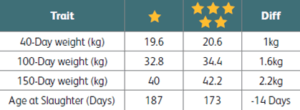
Star Terminal rams, weigh on average 2.2kg heavier than the 1-Star lambs. These lambs are followed right through to slaughter, and our data also shows that lambs sired by 5-Star Terminal rams were slaughtered 14 days sooner than lambs sired by 1-Star rams in these commercial flocks. In Summary, selecting 5-Star rams on the Terminal Index to breed lambs destined for slaughter results in increased lamb weight gain, and progeny reaching slaughter at a younger age.
In Figure 1, the results show that using 5-Star Terminal Rams reduces lambs age at slaughter by 14 days compared to 1-Star Rams.
To assess the usefulness of the genetic indexes in detecting differences in performance between animals performance data across a range of key areas including: lambing, lamb performance, ewe performance & health traits (dagginess) recorded between 2017 and 2021 were extracted from the Sheep Ireland database; the data consisted of both crossbred (28%) and purebred (72%) animals. The number of records available differed per trait but varied from 105,248 to 37,587 records. To quantify the accuracy of the Irish maternal genetic evaluations for improving maternal traits in the national flock, individual animal breeding values for maternal traits were compared to performance on farm for the same trait.
In Figure 2, results show that 5 star ewes across a range of maternal traits had greater reproductive performance on farm. Ewes with a 5 star rating for fertility (i.e. the number of lambs born breeding value) produced, on average, an additional 0.38 lambs per lambing compared to a ewe of 1 star for the number of lambs born breeding value. Although 5 star ewes produced a 0.23 kg heavier lamb at birth, 5 star ewes had experienced lower levels of lambing difficulty (10% less lamb dystocia) compared to ewes of 1 star for the relevant trait. Lower lamb mortality was also associated with ewes of 5 star rating for lamb survival, on average, 5% more lambs survived at lambing compared to 1 star ewes. Greater growth rates were also seen with lambs born to 5 star ewes both at pre-weaning and weaning with lambs born to 5 star ewes 0.64 kg and 1.62 kg heavier at pre-weaning and weaning compared to lambs born to 1 star ewes, respectively. Animals of 5 star rating also had a lower dag score (0.56 score) compared to animals of a 1 star rating.
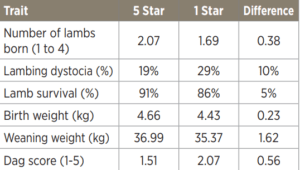
Results from this research indicate that selection of breeding animals for favorable maternal genetic attributes will result in favorable improvements in performance and profitability at farm level. Genetic evaluations are an important tool for sheep farmers to make more informed breeding decisions for increasing farm profitability.
2. How do I know what I am looking for when it comes to €urostar Indexes?
Firstly, you need to think about your breeding strategy for your flock. What traits do you want to enhance? Are you breeding to keep or sell replacements, or are you breeding to produce lambs for slaughter?
If a ram is being selected to breed some replacement females, then he should be 4 or 5 Star on the Replacement Index. The Replacement Index is a combination of Lamb Survivability, Number Lambs Born, Days to slaughter, Ewe mature weight and Daughters Milk, along with some other novel traits. The reason Days to slaughter is included in the Replacement index is to take into account that half of the lambs produced will be male, all of which will be destained for slaughter, along with a small proportion of females that were not retained for breeding.
If a ram is being selected to only breed slaughter/factory lambs, then he should be 4 or 5 Star on the Terminal Index. Lamb Survivability and Days to Slaughter contribute to the overall Terminal Index.
If I want a ram for dual purposes, what Index(s) do I select on?
If a ram is being selected for breeding both replacement females with any males and unwanted females going for slaughter, then he should be a 4 or 5 Star on the Replacement Index as all of the Terminal traits such as lamb growth are incorporated into the overall Replacement Index as well.
3. How do I interpret €urostars on catalogues?
When looking at a catalogue, it can be daunting to interpret what the contents displayed mean. €uroStars attached to an animal remain to be WITHIN BREED, ranking each index in 20% groupings. The higher the stars, the higher the predicted profitability from that animal within that breed. Since 2019 the €uro values of each trait and index can be compared ACROSS BREEDS, which allows any two rams to be compared to each other regardless of breed.
Lets walk through two different scenarios to see how this information would affect a farmers decision. If we assume in this case that the farmer intends to produce 100 lambs per year from this ram, and that he will be used for 4 breeding seasons. That means the ram will produce approximately 400 lambs in his lifetime.
Scenario 1: The farmer has decided they want a ram to breed replacement females, and he is happy to use a Charollais or Texel to do this. Below are the two potential rams they have identified. Ram A has a Replacement Index of €2.75 (1), and Ram B has a Replacement Index of €-0.70 (2).
RAM A: €2.75 x 400 lambs = €1,100
RAM B: -€0.70 x 400 lambs = -€280
Predicted Difference in Profit between Ram A & B= €1,380
The consequence of this decision is the predicted difference in adding €1,100 to the bottom line or losing €280 based on the genetic potential of each ram. In this scenario, RAM A is the better ram.
Scenario 2: The farmer has decided he wants a ram to breed only factory lambs, and he is happy to use a Charollais or Texel to do this. Below is are the two potential rams he has identified. Ram A has a Terminal Index of €0.46(1) and Ram B has a Replacement Index of €1.41 (2).
RAM A: €0.46 x 400 lambs = €184
RAM B: €1.41x 400 lambs = €564
Predicted Difference in Profit between Ram A & B= €380
The consequence of this decision is the predicted difference in adding €564 to the bottom line or €184 based on the genetic potential of each ram. In this scenario, RAM B is the better ram.
These scenarios are based on selecting one ram, if a farmer uses a team of rams, they could be losing a lot of performance and profitaby by not using the €urostars as a tool when selecting their breeding rams.
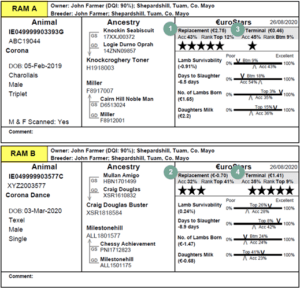
Below in Figure 4, each of the €urostars are broken down into percentiles which facilitates farmers in identifying the top % of the best genetics within a particular breed, ie a 5 star Texel ram – is in the top 20% within the Texel breed.
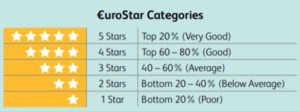
1) Replacement (€3.44) – If a farmer desires a ram to breed both lambs both for slaughter and replacement ewe lambs then they should select a ram based on this index. The bulk of this index is a combination of Lamb Survivability, Days to Slaughter, No. of lambs born & Daughters milk. The ¼ value beside the index represents the difference in profit that each lamb sired from this ram will have. This € value is an across breed value, so different breeds can be compared to each other.
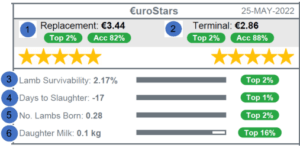
2) Terminal (€2.86) – If a farmer desires a ram to breed only lambs for slaughter then they should select a ram based on this index. The bulk of this index is a combination of Lamb Survivability and Days to Slaughter. The ¼ value beside the index represents the difference in profit that each lamb sired from this ram will have. This € an across breed value, so different breeds can be compared to each other.
3) Lamb Survivability – This ranks animals based on lambing ease and lamb survival rate. Every positive % point on this index is an extra lamb surviving to 40 days and vice versa.
4) Days to Slaughter – This ranks animals on their genetic ability to grow. The index associated with this trait represents the difference in the predicted number of days required for the progeny of this ram to reach the desired slaughtered weight compared with other animals of the same breed.
5) No. of Lambs Born – This ranks animals based on the predicted prolificacy of the females from this animal compared with other animals of the same breed.
6) Daughters Milk – This ranks animals based on the predicted milking performance of their daughters compared with other animals of the same breed.
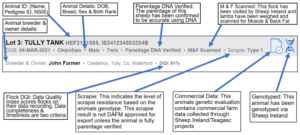
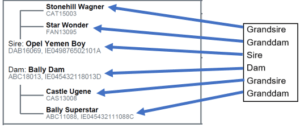
3.1 How can a ram have a poor rating for number of lambs born, and still be 5 star on the replacement index?
The replacement index is made up of a combination of lamb survivability, ewe mature weight, lambing difficulty, number of lambs born and lamb growth traits, each of which are weighted according to their effect on flock profitability. Where an animal is weak on one trait but strong in all other traits that make up the overall Replacement Index this can make up for the trait the ram is weaker on.
3.2 Should physical checks be carried out on rams?
Regardless of what €uroStar Index a ram may have, if the ram is not physically correct, he should not be selected. All farmers should carry out a ram NCT (check) on all existing stock rams and rams being considered for purchase. There are five basic things all sheep farmers should consider at – these can be summarised as the 5 T’s;
- Timing – assessed 10-12 weeks prior to breeding season
- Tone – ensure good condition, fit for purpose and not over fat
- Teeth – check for bumps/abscesses etc
- Toes – as well as legs – check for lameness, injury etc
- Testicles – check for lumps, small or undescended, the penis should also be checked for any injury or infection
4. How confident can we be with the info behind the €urostars and what is Sheep Ireland doing to monitor it?
The Data Quality Index (DQI) is a significant measure that has been implemented to ensure the highest standard of data integrity. Sheep Ireland does not publish €uroStar indexes for breeders where their DQI is lower than 40%. The minimum DQI required for the annual Sheep Ireland multibreed ram sale in Tullamore is 75%.
Flock visits are another important measure introduced by Sheep Ireland in 2019. During the flock visits a Sheep Ireland technician gives one to one advice on data collection as well as allowing Sheep Ireland to validate previously submitted data by the breeder, and where issues are identified action is then taken. Sheep Ireland implemented robust measures over the last number of years to ensure the integrity of data flowing into the genetic evaluations. Weight brackets have been implemented and tailored to the type and breed of animal that weights are being entered for. Weight reports are generated, flagging any animals that have a significant loss or gain in weight. A follow up with breeders is conducted to establish what caused this loss or gain in weight.
Similarly, other automated reports are generated from other information inputted and database checks are analysed for inconsistencies. Several breeders have been removed since 2019 as the identified inconsistencies could not be satisfactorily explained.
5. What is the DQI and why it is important?
The Data Quality Index (DQI) scores LambPlus flocks on the quality, quantity, and timeliness of their data recording throughout the year. The DQI appears as a % figure on all €uroStar sale catalogues, and on the Sheep Ireland online breeder and ram search found at www.sheep.ie.
On a sales catalogue, as seen below in Figure 8, the DQI is displayed in brackets after the owners name.

The three main elements of the DQI are as follows;
- Quality – Does the data demonstrate realistic variation across the various traits recorded, ie lamb mortality, lambing difficulty, lamb weights etc. For all traits, there are expected levels of variance and these are a great indicator of data quality.
- Quantity – Has the breeder recorded all the required data for their flock, ie lambing information for all ewes, weights for all lambs born etc. Complete data recording is beneficial to the users of the €uroStars as it maximises the accuracy % of the indexes.
- Timeliness – Has the breeder submitted their data to Sheep Ireland in a prompt manner. The prompt entry of data to Sheep Ireland reduces the risk of data error and/or loss. Late data entry has the potential to cause index movements coming into the ram sale season, which is very undesirable for both ram breeders and ram buyers alike. A high DQI is an indicator that the breeder in question is more engaged in performance recording and this has been demonstrated in practice with high DQI breeders making more genetic gain on both the Replacement and Terminal Index than low DQI flocks.
The DQI scores breeders from 0 – 100%. A guide for ram purchasers on DQI scores is as follows;
- DQI above 90% is excellent
- DQI above 80% is very good
- DQI above 70% is good
- DQI above 60% is average
6. Why do €urostars change and how often?
The €uroStars are updated on a weekly basis, from the spring until autumn. During this period is when the most influential data is submitted. The €urostars are based on the most recent data available before each weeks genetic evaluation. The date of the latest published €urostars will be indicated in the top right-hand side of the sales card in catalogues and on the ram search. As more new information becomes available, this will be reflected in the animals €uroStars. This could mean the animals €uroStars increasing or decreasing, depending on the new data. Using high accuracy % rams will minimise evaluation movements.
The DQI helps to minimise the significant fluctuations in the €urostars. The DQI encourages farmers to input data in a timely manner to reduce sudden fluctuations occurring in the €urostars. Where farmers input a large volume of data at one time ie. lambing information along with 40-day and 100-day weights all at the same time, this will cause a surge of information flowing into that animal’s genetic evaluation which can result in movements in €urostars. Where animals have a low accuracy %, again these €urostars will be more likely to fluctuate as more data is recorded on that bloodline in the future.
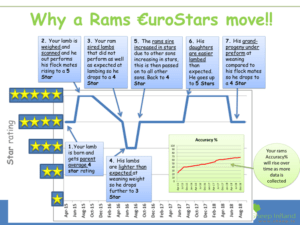
7. What is accuracy, and what affects it?
Accuracy % is displayed for each index and trait and represents the amount of data behind that specific index. Where Accuracy % is Poor, a considerably lower emphasis should be placed on the evaluation, however where Accuracy % is Good or V.Good a considerable emphasis can be placed on the evaluation when making a breeding decision. The more information that is available for an animal and its bloodline, the higher its accuracy % will be. Higher accuracy %, results in more dependable €uroStar evaluations.
This figure indicates more precisely where the animals rank within the breed. eg. Top 16% (see example below). This is displayed with a shaded line, the further to the right these are on the scale, the better its position within the breed, see Figure 10.

Top Tips in Relation to Accuracy%
- Try to purchase rams with as high an accuracy% as possible – This shows that there is a lot of data recorded for this bloodline
- Purchase genotyped rams – Genotyped rams have genomic information in their evaluation which considerably boosts the accuracy % of the €uroStar indexes
- Purchase from high Data Quality Index (DQI) LambPlus ram breeders; A high DQI illustrates that a breeder has recorded a high proportion of the data requested by Sheep Ireland annually
- Purchase rams that have Central Progeny Test (CPT) data in their background – The CPT is a ram testing programme which generates a large volume of commercial flock data on Irish sheep breeds annually. Purchasing rams with CPT tested sires in their ancestry is very desirable as this will result in higher accuracy %. CPT rams have been tested in commercial conditions on large grass-based farms, so this background data should be sought after by purchasers
Where Accuracy % is less than 10%, Sheep Ireland do not display the evaluation information for that index.
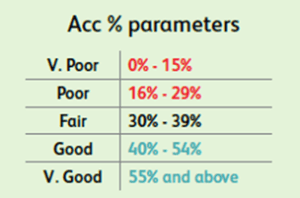
8. What is flock linkage and why it is important?
It refers to how genetically related/connected a performance recording flock is to other performance recording flocks. Flock linkage is critical to providing accurate genetic evaluations. Flocks become linked by sharing rams with other LambPlus flocks within the same season.
Why is Flock Linkage Important?
To strip away the effects that the environmental conditions and management type can have on an animal’s performance, we need genetic linkage between flocks. Analysing how the same genetics perform across different flocks allows us to make fair and accurate comparisons between flocks. Flocks that are unlinked only have a within flock evaluation. Therefore, you cannot reliably compare the €uroStar index of sheep from unlinked flocks with €uroStars of sheep from other flocks. Without flock linkage, it is very difficult for the evaluation to determine if an animals performance is due to genetics or due to the environment the animal has been raised in.
What is the difference between white and black stars on catalogues?
Rams with white €urostars represent €urostar evaluations that are only within the breeders flock, meaning this ram was only compared to other sheep in his breeders flock and not to any other sheep outside of the flock. This is an unlinked animal from an unlinked flock.
Rams with black €urostars represent €urostar evaluations are compared across multiple flocks, meaning this ram was compared to sheep outside of his breeders flock. This is a linked animal from a linked flock. When purchasing a ram, farmers should always aim to purchase from from linked flocks were possible.

9. Where can I find €urostar rams?
There is a range of options available to both pedigree ram breeders and commercial farmers who are looking to find a high €uroStar performance recorded ram.
Online Ram and Breeder Searches
There is a wealth of information available here for sheep farmers. The Sheep Ireland online ram and breeder searches can be found on www.ramsearch.ie or on the Sheep Ireland homepage (www.sheep.ie). Rams can be searched for based on breed, location, age and €uroStar index value. A new online breeder search facility was also launched, allowing users to search for performance recording ram breeders by breed and county. Take a picture of this QR code on your smartphone to go directly to the new online Sheep Ireland Ram Search.

Directory of LambPlus Breeders – A full list of LambPlus performance recording breeders can be found in the directory of LambPlus breeders which is updated every year. These breeders have €uroStar rams available for sale in the current year.
Sheep Ireland Multi-Breed Ram Sale – Sale takes place on the fourth Saturday of August each year in Tullamore Mart. Some of the best sheep genetics in the country are presented for sale here annually. A sales catalogue for this annual sale is available via the Sheep Ireland website approximately a week in advance of the sale.
Breed Society Ram Sales – The vast majority of breed society sales will have €uroStar evaluations included in their sales catalogues, but we would always recommend that you contact the relevant breed society in advance of any society ram sale to ensure that this is the case.
10. What is genotyping and why is it important for €urostars?
Genotyping is the process of determining the differences in the genetic make-up of an individual by examining their DNA. There are over 40,000 Irish sheep now genotyped, this bank of data is having a significant impact on the accuracy % of the €uroStars being produced by Sheep Ireland. Farmers will commonly see and hear of ‘Genomics’ which is referring to the implementation of genotyping as a whole.
Genomic evaluations offer us more accurate €uroStar evaluations on younger animals at an earlier stage of their life. 100’s of genomically tested ram lambs are available for sale in 2020 and can be seen with accuracies above 60%. These rams can be identified via RamSearch.ie.
Parentage Validation & Predictions and Scapie type- Incorrect animal parentage leads to an incorrect €uroStar Index. The €uroStars available for a ram lamb on the day of sale is heavily influenced by its family tree and data collected on that entire bloodline. Genomics can identify and correct parentage errors. Across all genotyped pedigree animals, when a sire error is identified based on the genomic test, in 44% of cases we can identify the correct sire. If we look only at the more recent 2019 born animals, this prediction rate increases to almost 60%. Over time as genotyping becomes more prevalent, this will grow further. When a animal is genotyped and parentage verified, a DAFM approved scrapie result is also reported. This helps build a picture of the current scrapie status of the flock.
11. How can performance recording become easier for commercial farmers?
The LambPlus App is available free of charge and is designed to make data recording quicker and easier for LambPlus members (Pedigree and Commercial). The App can connect to Bluetooth EID readers (on android devices only) if available and data recorded instantly loaded to the Sheep Ireland database. The App also records off-line with no internet connection, once re-connected the data automatically loads to the database. A FREE trial of the App is available by using the username ‘demo’ and the password ‘demo’ to get logged in. Available for download on Android and iOS. Use the same username and password you have for logging into the website on the App.
12. What info goes into €urostars?
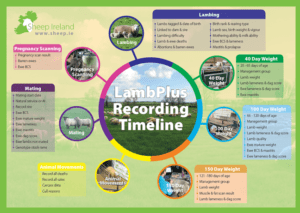
A huge amount of data is collected in LambPlus flocks to construct the €uroStar Indexes. This data is submitted by the LambPlus members themselves and collected independently by Sheep Ireland technicians during flock visits. LambPLus members are required to record Lambing, weights (birth, 40, 100, 150 day), mating, pregnancy scanning, animal health (dag, lameness, mastitis etc) and animal movements.
12.1 Does carcase data feed into the €urostars?
Yes. Carcass data was used introduced into the Irish Sheep genetic evaluations in 2019. The majority of carcass data collected to date has been collected from the CPT flocks.
Previously Days to Slaughter was predicted based on the live weight of the animal at 100/150 days of age, however this did not fully take into account how the animal would kill out. Figure 15 below shows an extreme example of two CPT Charollais Sires. Both rams produced progeny of a similar liveweight at 150 days of age (37.5kg). Previously both these rams would have received a very similar Days to Slaughter value. However, in the new evaluation, using the carcass records of these animals we can see the progeny of the first sire hit the required carcass weight after 192 days, while the progeny from the second sire took 205 days, that’s an extra 13 days for animals that had the same live weight at 150 days.
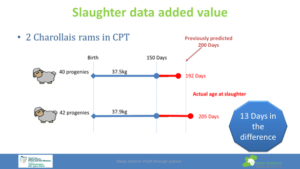
Recording carcase data benefits the bloodlines that produce heavier carcase weight at a younger age, and not just liveweight (even though these traits are strongly correlated). For flocks that have carcass data available on their performance recorded progeny, this can be loaded via the Factory Sale screen on the Sheep Ireland website to help increase the accuracy of their €uroStars.
Ultrasound Muscle and Fat Scanning remains an optional component of the LambPlus programme. Ultrasound scanning was historically used as a predictor of carcass confirmation and fat depth levels. It is used to replace factory carcass data when it is not available in abundant amounts. Ultrasound scanning remains to be a common practice in all the top breeding flocks involved in LambPlus and continues to contribute to the national breed improvement programme in Ireland. Similar to recording carcase data, muscle and fat depth scores contribute to the accuracy of €urotars.
